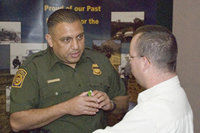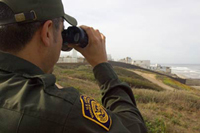Border Patrol Recruiter
Home | Contact | Training Academy | Border Patrol Job Fairs | Salary/Pay and BenefitsBorder Patrol History
The Origins of the Border PatrolThe U.S. Border Patrol has a proud history of over 75 years of service to our nation. Although enormous changes have affected nearly every aspect of its operations from its earliest days, the basic values that helped shape the Patrol in the early years; professionalism, honor, integrity, respect for human life, and a shared effort, have remained. Mounted watchmen of the U.S. Immigration Service patrolled the border in an effort to prevent illegal crossings as early as 1904, but their efforts were irregular and undertaken only when resources permitted. The inspectors, usually called Mounted Guards, operated out of El Paso, Texas. Though they never totaled more than seventy-five, they patrolled as far west as California trying to restrict the flow of illegal Chinese immigration. In March 1915, Congress authorized a separate group of Mounted Guards, often referred to as Mounted Inspectors. Most rode on horseback, but a few operated cars and even boats. Although these inspectors had broader arrest authority, they still largely pursued Chinese immigrants trying to avoid the Chinese exclusion laws. These patrolmen were Immigrant Inspectors, assigned to inspection stations, and could not watch the border at all times. Military troops along the southwest border performed intermittent border patrolling, but this was secondary to "the more serious work of military training." Aliens encountered illegally in the U.S. by the military were directed to the immigration inspection stations. Texas Rangers were also sporadically assigned to patrol duties by the state, and their efforts were noted as "singularly effective." Jeff Milton, first Border PatrolmanAlways referred to as "the first Immigration Border Patrolman", Jeff Milton poses outside the Birdcage Theatre in Tombstone, Arizona. Milton became a Texas Ranger in 1879, at age 18, and was one of the men who hunted down Victorio and Geronimo. He later joined the U.S. Immigration Service. Milton died in his home in Tucson, Arizona in 1947. Customs violations and intercepting communications to "the enemy" seemed to be of a greater concern than enforcing immigration regulations in the early years of the twentieth century. Agencies charged with inspecting people and goods entering and leaving the U.S. noticed that their efforts were totally ineffective without border enforcement between inspection stations. After 1917, a higher head tax and literacy requirement imposed for entry prompted more people to try to enter illegally. In 1918, Supervising Inspector Frank W. Berkshire wrote to the Commissioner-General of Immigration expressing his concerns about the lack of a coordinated, adequate effort to enforce immigration and customs laws along the border with Mexico. "If the services of men now being drafted cannot be spared for this work, it may be that the various departments vitally interested would give favorable consideration to the formation of an independent organization, composed of men with out the draft age. The assertion is ventured that such an organization, properly equipped and trained, made up of seasoned men, would guard the border more effectively against all forms of lawlessness than a body of soldiers of several times the same number ..." Prohibition and Border ControlThe Eighteenth Amendment to the United States Constitution, prohibiting the importation, transport, manufacture or sale of alcoholic beverages went into effect at midnight on January 16, 1920. With the passage of this constitutional amendment and the numerical limits placed on immigration to the United States by the Immigration Acts of 1921 and 1924, border enforcement received renewed attention from the government. The numerical limitations resulted in people from around the world to try illegal entry if attempts to enter legally failed. Therefore, the mission of the Border Patrol became more important to the U.S. Government. These events set the wheels of change into motion. On May 28, 1924, Congress passed the Labor Appropriation Act of 1924, officially establishing the U.S. Border Patrol for the purpose of securing the borders between inspection stations. In 1925 its duties were expanded to patrol the seacoast. The Early YearsOfficers were quickly recruited for the new positions. The Border Patrol expanded to 450 officers. Many of the early agents were recruited from organizations such as the Texas Rangers, local sheriffs and deputies, and appointees from the Civil Service Register of Railroad Mail Clerks. The government initially provided the agents a badge and revolver. Recruits furnished their own horse and saddle, but Washington supplied oats and hay for the horses and a $1,680 annual salary for the agents. The agents did not have uniforms until 1928. In 1932 the Border Patrol was placed under the authority of two directors, one in charge of the Mexican border office in El Paso, the other in charge of the Canadian border office in Detroit. Liquor smuggling was a major concern because it too often accompanied alien smuggling. The majority of the Border Patrol was assigned to the Canadian border. Smuggling was commonplace along the Mexican border also. Whiskey bootleggers avoided the bridges and slipped their forbidden cargo across the Rio Grande by way of pack mules along the Southern border. President Franklin D. Roosevelt combined the Bureau of Immigration and the Bureau of Naturalization into the Immigration and Naturalization Service in 1933. The first Border Patrol Academy opened as a training school at Camp Chigas, El Paso, in December 1934. Thirty-four trainees attended classes in marksmanship and horsemanship. Although horses remained the transportation of choice for many years, by 1935, the Border Patrol began using motorized vehicles with radios. Rugged terrain and the need for quick, quiet transportation guaranteed that horses would remain essential transportation to the Patrol even to the present day. The War YearsThe workload and accomplishments of the Patrol remained fairly constant until 1940, when the Immigration Service was moved from the Department of Labor to the Department of Justice. An additional 712 agents and 57 auxiliary personnel brought the force to 1,531 officers. Over 1,400 people were employed by the Border Patrol in law enforcement and civilian positions by the end of WWII. During the war, the Patrol provided tighter control of the border, manned alien detention camps, guarded diplomats, and assisted the U.S. Coast Guard in searching for Axis saboteurs. Aircraft proved extremely effective and became an integral part of operations. Border Patrol Role ExpandsLegislation in 1952 codified and carried forward the essential elements of the 1917 and 1924 acts. The same year, Border Patrol agents were first permitted to board and search a conveyance for illegal immigrants anywhere in the United States. For the first time, illegal entrants traveling within the country were subject to arrest. As illegal immigration continued along the Mexican border, sixty-two Canadian border units were transferred south for a large-scale repatriation effort. In 1952, the government airlifted 52,000 illegal immigrants back to the Mexican interior. The program was terminated after it ran out of funds during its first year. The Mexican government offered train rides into the Mexican interior for nationals being returned from the San Antonio and Los Angeles districts, but this program was halted after only five months. Throughout the early 1950s, a special taskforce of 800 Border Patrol agents was assigned by the United States Attorney General to round up and ship home thousands of illegal immigrants in southern California. The task force moved to the lower Rio Grande valley, then to Chicago and other interior cities. The Border Patrol began expelling adult Mexican males by boatlift from Port Isabel, Texas, to Vera Cruz in September 1954. The project was discontinued two years later after nearly 50,000 illegal aliens had been returned home. Various other flights, train trips, and bus trips originated along the border and terminated in the Mexican interior. In spite of the major successes in repatriation, many deportees simply turned around and recrossed the seriously undermanned border. Repatriation programs proved extremely expensive and were phased out primarily because of cost. Early repatriation effortsSignificant numbers of illegal aliens began entering the U.S. on private aircraft in the late 1950s. In cooperation with other federal services, the Border Patrol began tracking suspect flights. During the Cuban missile crisis of the early 1960s, Cuban defectors living in Florida flew aircraft out over the ocean in an effort to harass their former homeland. The American government made this harassment illegal, and assigned the Border Patrol to prevent unauthorized flights. The Patrol added 155 officers, but discharged 122 of them when the crisis ended in 1963. The early 1960s also witnessed aircraft-hijacking attempts and President John F. Kennedy ordered Border Patrol agents to accompany domestic flights to prevent takeovers. The Miami Sector of the Border Patrol coordinated the effort. By that time the business of alien smuggling began to involve drug smuggling also. The Border Patrol assisted other agencies in intercepting illegal drugs from Mexico.Today's Border PatrolThe 1980s and 1990s saw a tremendous increase of illegal migration to America. The Border Patrol responded with increases in manpower and the implementation of modern technology. Infrared night-vision scopes, seismic sensors, and a modern computer processing system helped the Patrol locate, apprehend, and process those crossing into the U.S. illegally. In an effort to bring a level of control to the border, Operation "Hold the Line" was established in 1993 in El Paso, and proved an immediate success. Agents and technology were concentrated in specific areas, providing a "show of force" to potential illegal border crossers. The drastic reduction in apprehensions prompted the Border Patrol to undertake a full-scale effort in San Diego, California, which accounted for more than half of illegal entries. Operation "Gatekeeper" was implemented in 1994, and reduced illegal entries in San Diego by more than 75% over the next few years. A defined national strategic plan was introduced alongside Operation Gatekeeper and set out a plan of action for the Border Patrol into the future. With illegal entries at a more manageable level, the Patrol was able to concentrate on other areas, such as establishing anti-smuggling units and search and rescue teams such as BORSTAR. The Border Safety Initiative (BSI) was created in 1998 with a commitment by the Border Patrol and the promised cooperation of the Mexican government. Homeland security became a primary concern of the nation after the terrorist attacks of September 11, 2001. Border security became a topic of increased interest in Washington. Funding requests and enforcement proposals were reconsidered as lawmakers began reassessing how our nation's borders must be monitored and protected. Several reorganization plans continue to be debated to increase the Border Patrol's effectiveness. The U.S. Border Patrol continues its efforts to control our nation's borders. The 21st century promises to provide enormous leaps in technology that can be applied to border enforcement. The modernization of the Patrol advances at a dizzying rate as new generations of agents develop innovative ways to integrate the contemporary technology into field operations. New and specialized technology is being created within the Border Patrol that holds increasing potential to assist agents in fulfilling the mission of the Patrol. Additionally, cooperation with neighboring countries increases border safety and law enforcement efforts. The future of the U.S. Border Patrol promises to be as exciting and interesting as its past, and will continue to echo the motto that agents have lived by since 1924. |
Request More Info |
Fill out the form below and you'll get information on how to apply, your local recruiter office contact information, and answers to your questions about the Border Patrol Agent hiring process. * All fields are required |
 Recruiters can answer your questions about the job. |
